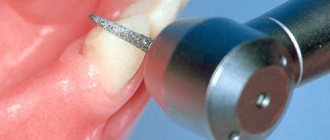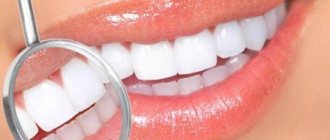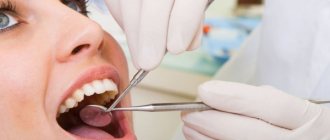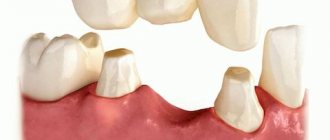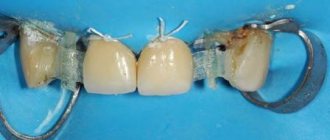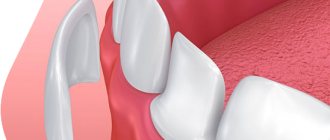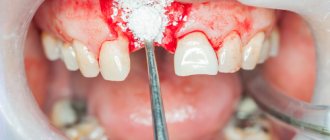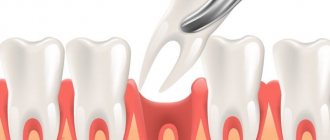- Home » Articles » Is it necessary to depulp a tooth under a crown?
14 September 2021
A dental crown is a prosthetic solution that allows the restoration of severely damaged teeth in situations where reconstruction cannot be performed with a composite material. Crowns can be made of metal ceramics, solid ceramics or zirconium (the most popular options). But they have one thing in common: a properly made crown can serve patients as long as a natural tooth. And the basis of proper manufacturing is proper preparation for prosthetics.
How we do it at Amazing Price Dentistry:
PROMOTION
Dental restoration, installation of fillings
from 2200 rub.
The importance of prosthetics
The main reason for refusals to install dentures is associated with the erroneous opinion of old-school dentists about the mandatory depulpation (removal of the nerve) of teeth before prosthetics. Before dispelling this myth, it is necessary to recall the importance of timely prosthetics.
Without an adequate prosthesis, neighboring healthy teeth begin to carry an unusual load, which leads to their increased wear, mobility and early loss. In addition, in the absence of even one tooth, speech defects appear, chewing functions are disrupted, bite pathologies occur, and even facial proportions are distorted.
Why and when is depulpation performed?
The doctor decides not to remove the neurovascular bundle in the following cases:
- the tooth is completely healthy, but does not take part in chewing food, or vice versa, the load when chewing is excessive;
- the tooth must be covered with a crown due to external defects (enamel hyper-abrasion, hypersensitivity, etc.);
- The crown is placed on the tooth, which serves as the basis for a fixed bridge prosthesis.
It is possible to keep the pulp chamber intact only if the molars and premolars are covered with a crown. In these units, the nerve bundles are hidden deeply, and the anterior single-root units should definitely be depulped before prosthetics.
After removing the nerve endings from the root canal unit, the dentist places a temporary crown. It is needed for:
- aesthetics;
- functionality;
- preventing damage to gums and dental tissues exposed after grinding.
Also, the temporary structure plays an important role in adaptation and elimination of diction disorders after fixation of the permanent crown.
When is it better to refuse the procedure?
- In general severe condition
- In the last trimester of pregnancy
- During exacerbation of hypertension
- For myocardial infarction
Almost all contraindications are relative; once the condition is normalized, removal of the beam becomes possible.
If it is not possible to postpone the procedure, the tooth is removed. The operation allows you to get rid of pain, but poses new problems, because in this case the dentition will have to be restored.
The nerve was removed, but the tooth hurts
Pain in the first days after pulp removal is a normal reaction of the body to the intervention. The tooth may hurt, ache, or even twitch. Usually everything goes away in 1-2 days. But if the pain is acute, does not subside within several days, is accompanied by fever, or a general deterioration in health, you need to consult a doctor.
Causes:
- Doctor's mistakes
- Incorrectly selected tools
- A piece of the tool broke off
- Low quality filling material
You can avoid these troubles if you go to a clinic with good recommendations, where such a service will be provided without traumatic consequences.
Cost of tooth depulpation (depulpation)
How much does it cost to depulp an upper front or lower back tooth?
The cost of tooth removal in Moscow on a turnkey basis depends on the following factors:
- microscope applications
- dentist qualifications
- pricing policy of the dental clinic.
- High-quality dentistry in Moscow
- Israeli Adin implants
- All-on-4 dental implantation
- All-on-6 implantation
- Israeli implants Alpha Bio
- Alternative to Dental Implants
- American dental implants
- German Ankylos implants
- Dental implantation for bone tissue atrophy
- Basal dental implantation
- Partial dental implantation
- Professional cleaning of dental implants
- Cleaning your teeth before installing implants
- Dental implantation or dentures: which is better?
- Korean Dentium implants
- Cheap dental implants
- Two-stage dental implantation
- Express dental implantation
- German ICX implants
Request a call back or dial our number!
+7
This phone call does not obligate you to anything. Just give us a chance and we will help you!
Just pick up the phone and call us!
+7
We will definitely make you an offer that you cannot refuse!
Stages of nerve removal
Like any medical procedure, nerve removal requires preliminary preparation.
It begins with interviewing the patient.
The doctor finds out the nature of the pain (if this is not a planned operation before prosthetics), its manifestations. What causes attacks: chemical, mechanical, temperature stimuli. How long the attacks last and how much time passes between them. The dentist must collect anamnesis, information about common diseases, allergic reactions. The patient is told how the operation will proceed and what to expect at each stage.
Diagnostics
The dentist begins the examination, paying attention to signs of inflammation. An X-ray image allows you to assess the condition of the canals, the size of the dentin, and the presence of formations on the roots.
According to indications, the doctor can use chemical, thermo and electrometric methods. Their goal is to find out how the tooth reacts to irritation with electricity (this is the main indicator that the pulp is “alive”), temperature and an alcohol solution.
Operation
Removal of the nerve is a surgical treatment method. There are 2 ways to depulp a tooth. The first method is more modern and is most often used. This is pulp removal under anesthesia. This method is called vital. Previously, the vital method was used mainly on the front teeth, but now the vast majority of depulpations are carried out using this method, regardless of whether they are lower, upper, chewing or anterior teeth.
- The oral cavity is treated with disinfectant solutions
- Anesthesia is administered (injection, anesthesia)
- Remove carious tissue
- Provide access to the pulp
- They delete it
- Expanding channels
- Clean them up
- Carry out medicinal treatment
- Fill the channels with sealer
- Filling a tooth
The process takes one visit
.
In case of allergies to painkillers, the presence of narrow, curved channels, or increased sensitivity, the devital method is used. Before removal, the pulp is mummified by applying arsenic or paraformaldehyde paste. The cavity is carefully closed with a temporary filling so that the substance does not get on the mucous membranes of the mouth. The patient walks with the medicine for up to 7 days
.
During the second visit, the temporary filling and the preparation are removed. Further removal of nerves and filling of canals follows the same protocol as in the first method.
Direct indications for depulpation
Dentists decide to remove a neurovascular bundle only if the patient:
- the nerve is partially exposed;
- tooth hypersensitivity;
- caries has reached the root canal;
- mechanical damage to the unit;
- anatomical pathologies (improper position of the tooth, large canal inclination).
The dentist is especially careful in choosing the method of prosthetics for the tooth that is planned to be used as a support for the structure.
